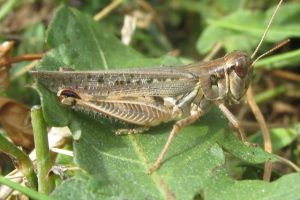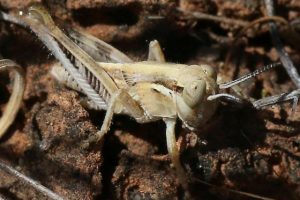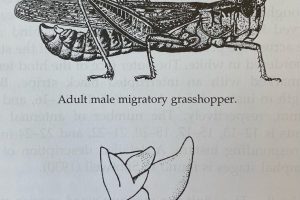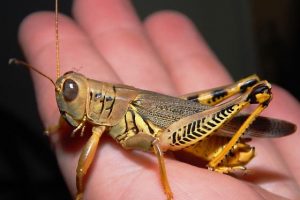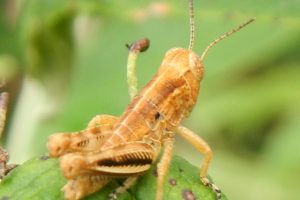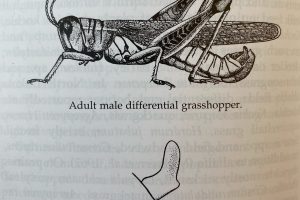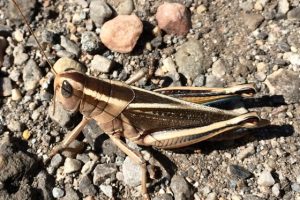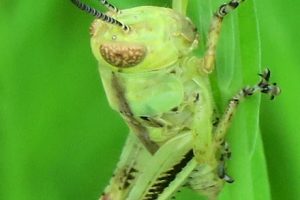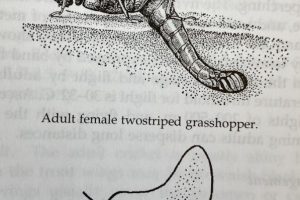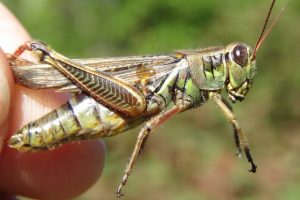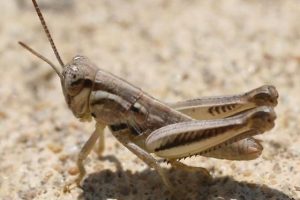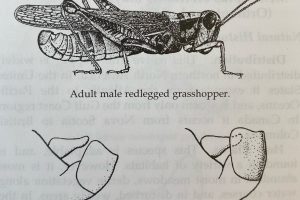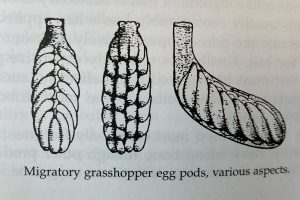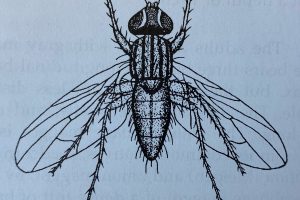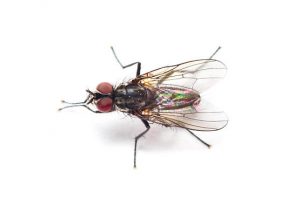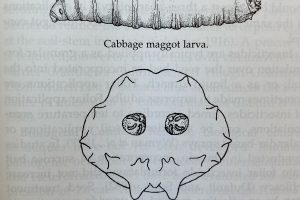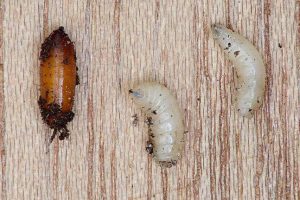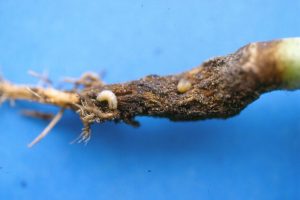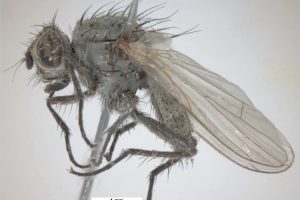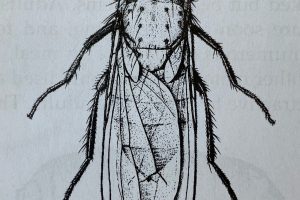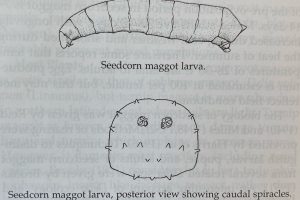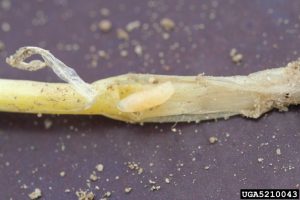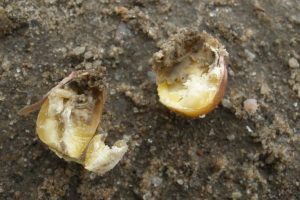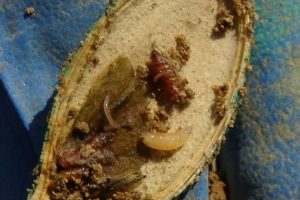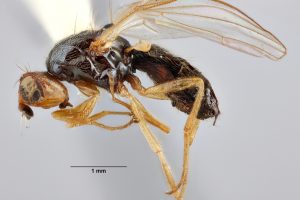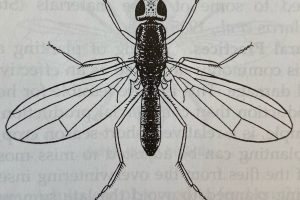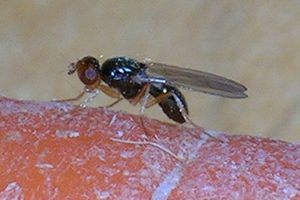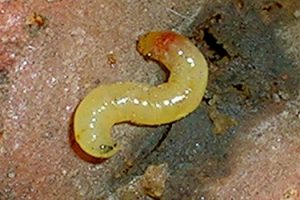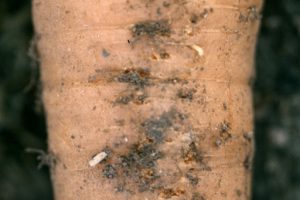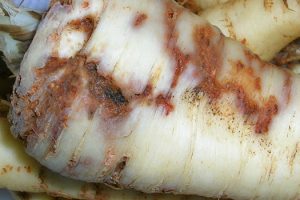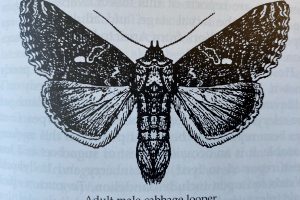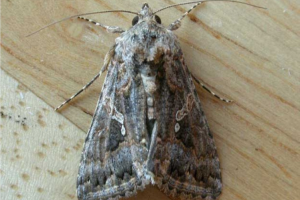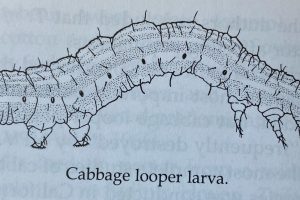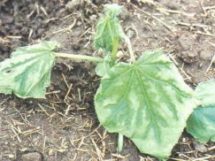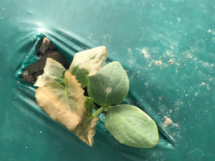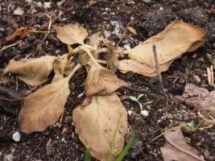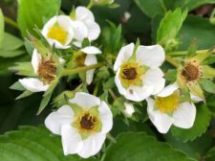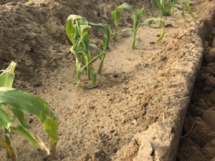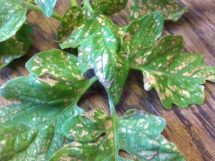In this Issue:
- Grasshopper Nymphs
- Root Maggots
- Cabbage Looper
- Identifying Cold Damage
GRASSHOPPER NYMPHS
Occurrence: Active Now | Grasshopper nymphs are currently emerging throughout the state. Population densities vary by location as they’re affected by the weather. Due to Utah’s mild winter and dry spring growers should prepare for high numbers this season. Infestations are not equal in all areas)
Description: Grasshoppers belong in the order Orthoptera and family Acrididae, and are most closely related to crickets and katydids. The acridid grasshoppers include some of the most injurious species in Orthoptera. Utah has three major groups of grasshoppers: the slant-faced grasshoppers, the band-winged grasshoppers, and the spur-throated grasshoppers. The slant-faces, as their name implies, generally have angled faces and long, thin bodies that enable them to blend into the grassy vegetation. The banded-wings are the conspicuous hoppers with often brightly colored hindwings that snap and crackle as they fly short distances. The banded-wings are especially common in open desert and scrub; they blend in well with their brown surroundings. The spur-throats include the most injurious species. Their name derives from the tubercle projecting between their front legs.
Female grasshoppers lay eggs in undisturbed soils in late summer and fall. Eggs hatch in mid-to late-spring when soil temperatures warm and new nymphs feed on nearby plants. In some years, populations can increase in undisturbed areas and move into crop sites where they cause massive defoliation. Most grasshopper species in Utah have one generation per year.
Grasshoppers have chewing mouthparts that leave random, ragged holes in leaves and flowers (Fig. 5.21), and can devour entire plants. In general, they prefer young green plants of corn, lettuce, bean, carrot, onion, some annual flowers, and melons. Damage occurs in the early summer after rangeland weeds dry up and usually lasts for a few weeks.
- Reference our fact sheet on Grasshoppers in Utah for descriptions of the specific species.
- 2021 Rangeland Grasshopper Hazard Outlook (USDA APHIS)
Management:
The problem with having several different species of grasshoppers is that some hatch early in the year while others hatch in the middle, so there’s a continual life cycle of grasshoppers occurring.
Because grasshoppers can travel long distances, especially as adults, it is important to treat large areas. The best time to treat is in mid-spring when nymphs are young. Reference our fact sheet on Community-Wide Grasshopper Control.
- Use floating row covers or lightweight plant fabric. Row covers will exclude the grasshoppers and should be removed during crop flowering for pollination. This can be done in the morning hours when pollinators are most active.
- Hand removal. Grasshoppers can be handpicked and squashed, especially when populations are low.
- Use baits. The insecticide, carbaryl, is mixed with wheat bran to create a bait. Spread it evenly throughout the habitat and reapply weekly. The bait can also be placed inside a container, such as PVC pipe segments, to protect it from getting wet (wet bait is no longer attractive to grasshoppers).
- Insecticidal dusts have short residuals and must be reapplied weekly and after rain or irrigation.
- Sometimes aerial sprays can be coordinated with the Utah Department of Agriculture and Food. The USDA threshold for rangelands is 9 nymphs per yd2; agricultural thresholds would likely be lower.
Nosema locustae is a biological insecticide bait that must be applied to early nymph stages and is specific to grasshoppers. After feeding on the bait, grasshoppers stop feeding, become lethargic, and die. The disease is contagious and will infect other grasshoppers that cannibalize diseased grasshoppers in the area.
CABBAGE MAGGOT
Occurrence: Active Now | Predict adult cabbage maggot emergence using a 43°F base temperature degree day model where calculations begin once the ground has thawed. First-generation adults appear after 300 degree days have accumulated. Second and third-generation adults appear after 1476 and 2652 degree days respectively have accumulated.
Description: Adult flies are dark with grey markings. Males bear three subtle black longitudinal bands on their thorax. The markings on females are much more distinct. Adults range from 5-7 mm. Eggs are laid at the soil level around the stem of cruciferous plants. They’re less than 1 mm in size. Females will lay 300-400 eggs during their 1-2-month lifespan. Larva (maggot) develops through three instars. At full maturity, they can reach 8 mm. The mouth hooks are black. Depending on the weather, the larval stage lasts 18-22 days. The pupa is brown, oval, and bluntly rounded on both ends.
Larvae (maggots) feed on the roots (and sometimes stems or petioles) of cruciferous crops such as broccoli, Brussels sprouts, cabbage, cauliflower, collards, kale, kohl-rabi, mustard, radish, rutabaga, turnip, and watercress. The key symptom of cabbage maggot feeding is wilting of the host plant.
SEEDCORN MAGGOT
Occurrence: Active Now | Seedcorn maggot development is estimated using a base temperature of 39°F (3.9°C) for degree-day calculation. Planting should be avoided during peak fly emergence, which occurs for the first three generations when 354, 1080, and 1800 degree–days have accumulated, respectively. (Click Here)
Description: Adult flies are greyish-brown with a few distinctive markings. Males bear stripes on their thorax and a mid-dorsal stripe on the abdomen. These stripes are usually lacking in females. Adults range from 4-5 mm. Eggs are less than 1 mm and are slightly curved. They’re laid on the soil surface. When hatched, larvae dig down into the soil looking for suitable hosts. The larva is white and develops through three instars growing to 7 mm at maturity. The pupa is a light reddish-brown.
Larvae (maggots) cause damage by feeding on seeds and developing embryos, often before the seedlings break through the soil. Larvae also penetrate seeds as the seed coat splits. This can lead to rotting as they burrow into the cotyledons. Host vegetables include artichoke, beet, Brussels sprouts, cabbage, cantaloupe, carrot, cauliflower, corn, cucumber, garlic, kale, lettuce, lima bean, mustard, onion, pea, potato, pumpkin, rhubarb, spinach, squash, sweet potato, tomato, turnips, and alfalfa.
CARROT RUST FLY
Occurrence: Active Now | Rare in arid regions such as the intermountain west. Adults begin emerging in mid-April through mid-June.
Description: Adult flies range 4.5-5 mm long. The head and legs are a yellow-brown color. The thorax and abdomen are shiny black. Subtle yellow hairs cover the abdomen and thorax. Their wings are somewhat iridescent. Eggs are laid in small clusters of 1-3 eggs. A female can lay an average of 40 eggs in their lifespan. When larvae (maggots) hatch they are initially colorless, but then a milky-white to yellow. At maturity, they range 6-9 mm. Pupa are a yellow-brown color and measure 4.5-5 mm long.
Larvae (maggots) are most destructive on carrots, but also attack other umbeliferous vegetable crops like celery, celeriac, parsnip, and parsnip. They mine the surface of the root leaving trails or blotchy areas. This feeding area often turns a rusty color, giving the fly its name.
Root Maggot Management:
- Monitor for cabbage maggots by using cone-screen traps baited lures that release isothiocyanates (a naturally occurring odor released by crucifers). These traps are often more effective than the traditional yellow sticky trap.
- Monitor for seedcorn maggots by cone traps baited with alcohol, odors of fermentation (from honey-yeast or molasses) which are highly attractive to the flies.
- Monitor carrot rust flies by placing yellow sticky traps near the base of host crops.
- Rotate susceptible crops with unrelated crops.
- Plant seeds into raised soil beds to promote soil drying and warming.
- Destroy or disc under crop residues immediately after harvest.
- Apply row covers for physical exclusion of adult flies.
- Harvest carrots in blocks (rather than selectively) as soon as possible. (Carrot rust flies)
- Remove all carrots from the ground after harvest. (Carrot rust flies)
Effective home-use insecticides registered for root maggot control in Utah.
| Active Ingredient | Products |
| pyrethrins | Monterey Bug Buster-O, Worry Free Insecticide and Miticide |
| pyrethrins + sulfur | Bonide Tomato and Vegetable 3 in 1, Natria Insect Disease & Mite Control, Ortho Insect Mite & Disease 3 in 1 |
CABBAGE LOOPER
Occurrence: Active Now | Adults emerge in late March to April. Moths immigrate from warmer regions in the south. (Cabbage Looper Phenology Model)
Description: Adults are brown-colored moths with a silvery figure eight or ‘U’ shape with a circle beneath on the front wings. Eggs are yellowish-white to green in color, dome-shaped with longitudinal ridges, and laid singly or in groups of 6 to 7 on the upper or lower surface of leaves. The larva is about 1½ inches long at maturity, with a white stripe along each side of their green body and several narrow lines along the back. Distinguished by their “loop-like” crawling where the midsection of their body forms a loop as they bring their back legs (prolegs) toward their front legs. The pupa is about ¾ inch long. The pupa develops inside a thin white cocoon on the underside of foliage, plant debris, or soil clods.
Cabbage looper prefers broccoli, cabbage, and cauliflower, but will feed on all cole crops. Larvae feed on outer leaves, resulting in round holes. Frass (excrement) can stain or discolor broccoli and cauliflower heads. As crop heads develop, cabbage loopers feed on outside leaves and bore into heads, resulting in unmarketable produce.
Management:
- Monitor. Scout weekly for cabbage loopers by randomly checking one out of ten plants (10%) in small fields, and one out of 100 plants (1%) in fields > 1 acre. Look on the undersides of leaves for small larvae and eggs. Look for feeding holes; search for larvae nearby and inside damaged heads.
- Use pheromone traps. Mount traps on a stake and place just above crop canopy height at the field edges. Use a pheromone lure specific to cabbage looper to attract male moths to the trap for counting. Moths fly at dusk and into the early nighttime. See pg. 25 for sources of monitoring supplies.
- Handpick caterpillars. Where practical (in smaller fields), physically remove larvae when plants are young or when only a few loopers are present.
- Use floating row covers. Apply covers before loopers are present to prevent adult moths from laying eggs on plants. Remove covers during flowering to allow for pollination. This option is only practical for home gardens and small commercial fields.
- Plant tolerant varieties. Cabbage varieties with resistance to cabbage looper include ‘Green Winter,’ ‘Savor,’ ‘Savoy Chieftain’, and most red cabbage varieties.
- Sanitation. Clean fields of plant debris after harvest, thus removing overwintering sites for pupae.
- Manage weeds to remove overwintering sites for pupae. Weed hosts for looper caterpillars include wild mustard, peppergrass, and shepherd’s purse.
Insecticides containing Bacillus thuringiensis var. kurstaki (Bt) and spinosad are effective in suppressing cabbage looper larvae. Bt must be applied when larvae are still young (< ½-inch long), and plant coverage is important as Bt must be ingested by larvae to be effective.
When more than one cabbage looper larva is found in one out of ten monitored plants (10%), treat just before heading or at Brussels sprout formation. Seedlings only require treatment if medium- to large-sized caterpillars are present, and defoliation (loss of plant tissue) exceeds 10%.
Effective home-use insecticides registered for cabbage looper control in Utah.
| Active Ingredient | Products |
| carbaryl | Garden Tech Sevin 5% Dust Bug Killer |
| cyfluthrin | BioAdvanced Vegetable and Garden Insect Spray |
| gamma-cyhalothrin | Spectracide Triazicide |
| permethrin | Bonide Eight Vegetable, Fruit & Flower |
| pyrethrins | Monterey Bug Buster-O, Worry Free Insecticide |
| zeta-cypermethrin | GardenTech Sevin |
| pyrethrins + insecticidal soap | Safer Brand Tomato & Vegetable Insect Killer |
| pyrethrins + sulfur | Bonide Tomato and Vegetable 3 in 1, Natria Insect Disease & Mite Control, Ortho Insect Mite & Disease 3 in 1 |
| Spinosad | Monterey Garden Insect Spray, Bonide Captain Jack’s Dead Bug, Natural Guard Spinosad Spray |
| Bacillus thuringiensis | Bonide Thuricide, Garden Safe Caterpillar Killer with Bt, Natural Guard Caterpillar Killer with Bt, Dipel Dust, Garden safe Bt worm and Caterpillar Killer |
Further Information:
- Caterpillar Pests of Brassica Vegetables (Utah State University Extension)
- High Tunnel Pest Management – Caterpillars (Utah State University Extension)
IDENTIFYING COLD DAMAGE ON VEGETABLES
With the risk of frost and cold temperatures still present in parts of northern Utah, many vegetable crops might receive cold injury or damage. Freezing temperatures can damage plants by rupturing plant cells as ice crystals form and rapid changes in temperatures occur.
Some factors related to cold injury or damage include:
- Lack of Hardiness: Some plants may not be completely hardy to your location in Utah. Use the USDA plant hardiness zone map to know your specific zone and select vegetables accordingly.
- Late-Season Frosts: late-season frosts in the spring can cause damage to plants that may have just adapted to the location. Allow transplants adequate time to harden off (adjust to outdoor conditions) to strengthen them before the cold temperatures. Reference the Utah Climate Center for historical freeze dates.
- Plants can also be damaged when unseasonably warm weather during winter or early spring stimulates the production of new growth. Cold snaps can be very damaging to this tender foliage.
- Unprotected Root Systems: Root systems that are unprotected above the ground are very susceptible to cold damage. On some otherwise hardy species, lethal root temperatures can begin at 28 °F.

